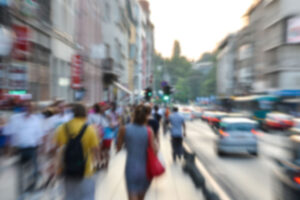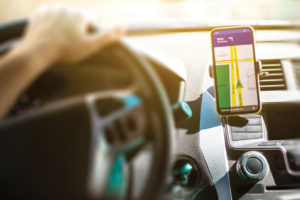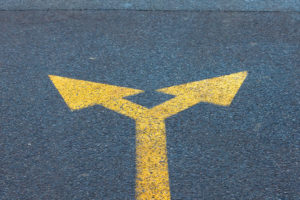By Michael Back
Contactless infrastructure has been in place for years but until now, consumers have not embraced this technology on a broad scale. As a result, parking operations have offered it inconsistently across the board. The tides are changing – but will it be a tsunami?
The climate around coronavirus has drawn particularly close attention to the cleanliness and safety associated with both cash and the high-touch payment technology that we use every day — from ATMs to retail pin pads to parking infrastructure. The new consumer hypersensitivity around previously simple conveniences of modern-day life will need to be re-examined post COVID-19.
Let’s start by considering just how unhygienic — and as a direct result — unsafe cash and high-touch payment technology happens to be:
We have known for years that banknotes harbour the perfect environment for microbes to settle. Past studies have shown that bills carry more than 3,000 types of bacteria including E. coli, Salmonella, and Staphylococcus aureus. But as the world comes together to stop the spread of COVID-19, what’s new is that governments are starting to undertake strong measures to alleviate coronavirus transmission via cash handling — China is disinfecting and locking away used banknotes, while the Bank of Korea is heating banknotes, and in some cases, burning the bills. In addition, the Bank of Korea will no longer handle the exchange of coins and banknotes that have been introduced from abroad.
Another powerful recommendation in the move away from cash comes from the World Health Organization, which has urged the population to avoid cash and to use contactless payments to reduce the risk of transmission of COVID-19. In an April 2020 study, The Lancet Microbe looked at how long the coronavirus lasts on various surfaces. Among their discoveries was that the…
By Marc-Antoine Ducas
Moving to and from the office can be a challenge for a lot of employees and it can be a headache for employers. Actual mobility solutions are not always optimal and some employees have to use their car. When office parking is saturated, companies have to offer better commuting options or face the prospect that valued employees will look at other job opportunities that make their life easier.
The solution is to encourage employee carpooling and there are numerous strategies that many companies already use to great effect. All successful employee carpooling programs have one element in common – make carpooling as easy and convenient as possible to position it as a viable alternative to commuting in a single-occupancy vehicle.
When coordinating carpools for large groups, obstacles such as differing work schedules, unpredictable weather and accounting for last-minute changes are inevitable, but the overall benefits do outweigh the challenges. As 100% of carpooling drivers have to park when they get to their destination, we realize that parking is the key incentive to change their behaviour. Travel time and use of high occupancy vehicle (HOV) lanes also interest people in carpooling.
Netlift works with companies to determine needs and constraints in relation to employee mobility. Our goal is to provide a sustainable mobility solution while optimizing parking facility usage.
Employees install the Netlift app and enter their commute route. Parking access, ride payment, employee contributions and reimbursements to drivers are all handled through the app, taking the hassle out of commuting and making the most of current parking facilities.
But when an organization runs out of parking spots then that means building new parking lots or hiring shuttle services, an important cost. Netlift’s ongoing objective is to optimize available parking by putting more people per car.
By Matt Jobin
The Coronavirus crisis has thrown our lives into chaos, and it’s changing the way that we, as parking professionals, think about parking.
The public health crisis will eventually pass, but even as it does, it will be important that cities, private parking owners, and organizations with parking assets work with their parking consultants learn from this crisis. This pandemic provides a stark reminder that people are susceptible to illness, and we should strive to find ways to minimize the risk.
As a parking facility designer, I’ve always considered safety to be one of the most important design elements. Until recently, though, these types of healthcare issues weren’t part of the equation. But as the Coronavirus crisis has shown, it should be. The parking process exposes people to many common “touch-points”, forcing drivers to touch surfaces that others (often many others) have already touched. This is how illness spreads, and as we are learning during this pandemic, viruses can live for several days on surfaces. This is an important issue, not just now, but in normal times too. We are constantly coming into contact with flu and cold viruses, as well as many types of bacteria. As such, cities and parking owners and their design teams need to be aware of where potential risks exist within parkades and how to mitigate them.
So, the question is, how can we reduce the risk of viruses being introduced to high-use surfaces within parkades?
Start with Technology
Technology can play an important role. There are a number of technologies already in use that can reduce touch-points. Perhaps the most common, and useful, are frictionless parking suites that use LPR to recognize a vehicle as it enters and exits, and automatically bills the driver’s credit card or associates the parking episode with a permit. These suites…
By David Burr
“Nobody goes there anymore; it’s too crowded.” – Yogi Berra
The traditional behavior of automobile drivers heading into the city center and finding parking has led to an untenable level of traffic and congestion in many cities. Urban roadways are at or beyond capacity and, as cities become denser and populations increase, this problem will only get worse. Anyone who has driven in a dense urban environment is aware of this, yet still they come, despite knowing the headaches and the hassles of driving and parking in these urban areas. The solution, of course, is not fewer people, but fewer vehicles.
To achieve this decreased use of individual cars within city centers, cities need to ask themselves what motivates drivers to continue this behavior, and then tailor alternative transportation solutions that accommodate these needs when possible. By developing programs and policies that encourage pedestrianism and the use of alternative transportation, as well as accommodating bicycle and scooter traffic as supplementary forms of transit, cities can begin to get closer to reducing urban vehicle traffic while not impairing use and access, but rather enhancing it.
A natural consequence of striving for this solution is that transportation, particularly as people move in and out of metropolitan corridors on daily commutes, is becoming more intermodal. In order to operate efficiently and accommodate the needs of people traveling into and around dense urban areas, and back out to less dense suburban areas, transportation systems also need to offer options and fully leverage the various forms of existing infrastructure and high density transit options available to them.
To drive adoption and increase the use of these various forms of transport, it is important to understand them functioning not individually, but rather as separate links in a greater transportation “chain”. A chain…
Smart Cities are the way of the future. Every city in Canada is already planning its evolution into a Smart City and some are beginning to implement the initial elements.
The success of this evolution will depend largely on parking technology. Drivers—and eventually those in autonomous vehicles—need to park, and making it easier to park will dramatically reduce congestion on city streets. In the not-too-distant-future, when we leave the house, we’ll just enter our destination into our car’s GPS and then the car will guide us directly to the closest available parking space to that destination. If we haven’t already reserved and paid for a parking space in advance, we’ll be able to pay with our cell phones. If we need more time than we paid for, we’ll get a text reminding us when it’s time to move the car and asking if we want to pay for more parking—which we can do with our cell phones, without returning to the car.
The Foundation of Smart Cities
Intelligent parking technology will play the key role. Intelligent parking uses parking guidance sensors located in or over parking spaces to monitor whether they are occupied or available, and transmits that information to strategically located signs to guide vehicles directly to available spaces.
Parking guidance is already common in parkades throughout Canada. While it’s primarily used as a driver amenity designed to make it easier to quickly and conveniently find an available parking space, it also helps parking organizations better manage their assets by providing real-time data about how those assets are being utilized. Additionally, parking guidance also helps organizations increase their occupancy by eliminating the risk that drivers will give up looking for a space and…
When the time comes to consider asphalt repair for your parking lot or driveway, you want to be absolutely sure you’re choosing the right option. Asphalt paving and sealcoating can appear similar on the surface—no pun intended—but these two maintenance and repair procedures are very different.
Asphalt Paving – The what, how, and when
Asphalt paving is the process where existing asphalt surfaces are either replaced or have a new layer of asphalt added on top of them. It’s most often used when asphalt is showing signs of deterioration or wear, such as large cracks and potholes, but when the wear is not bad enough to warrant a complete replacement.
There are a number of options for surface asphalt repair, depending on the issues your parking lot is facing:
Infrared repair – a process in which new and existing asphalt is blended together and compacted into the damaged area for seamless reparation of potholes and rough areas. This method is particularly effective due to the quality of the repair, reduced construction time, and economical advantages.
Pothole repair – asphalt mix is added to the hole after debris has been cleared away, which is then compacted with a multi-ton vibratory roller or a vibratory plate. This is, more often than not, a remedial repair and the hole may reform months or even weeks after the job.
Resurfacing – after the asphalt has been cleared of debris, a new layer of asphalt is applied to the old surface. Between these layers is tack coat, which bonds the two different asphalts together firmly. The new layer will measure the correct depth and be compacted with a multi-ton vibratory roller.









